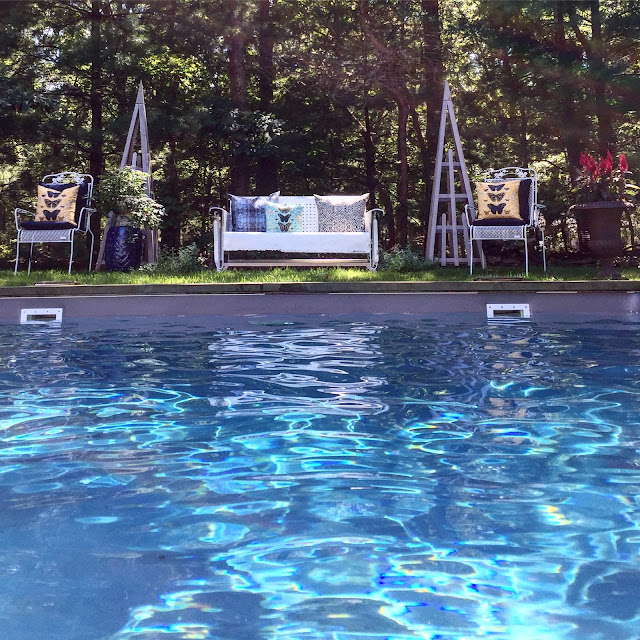WHY IN DESIGN COLUMN: A Summer Read That Walks You Through American History and Artists In The Hamptons, Hamptons Bohemia
Hamptons Bohemia
Two Centuries of Artists and Writers on the Beach
By Helen A. Harrison and Constance Ayers Denne
Foreword by Edward Albee, 2002
From Montauk Point
~Walt Whitman, 1888
I stand as on some mighty eagle's beak,
Eastward the sea absorbing, viewing,
(nothing but sea and sky),
the tossing waves, the foam,
the ships in the distance,
the wild unrest, the snowy, curling caps - that inbound urge and urge of waves,
Seeking the shores forever
A Must Summer Read:
Hamptons Bohemia
Inspires and Educates on the History of the Hamptons,
and the artists who call it home
Although it was published back in 2002, this book is my favorite summer read, every summer! There is a long history for artists and creative types who venture out to the Hamptons for refuge, fodder and playtime. Some artists claim it is the pure and honest sunlight, while others profess the sandy dunes or farmer fields offer inspiration. Winslow Homer painted here, Lee Krasner and Jackson Pollock set up a studio in Springs, and the likes of Herman Melville, F. Scott Fitzgerald, John Steinbeck, George Plimpton and other artists, writers and poets over the decades have found refuge from the city life within the shelter of the sandy beaches and gorgeous landscape.
Hamptons Bohemia walks the reader through the cast of characters and rich history, documenting and illustrating with archival photos this interesting community. There are many reasons the South Fork has become popular with this crowd, but one of the early pulls for artists were the whalers and seamen who traveled to Sag Harbor for a burgeoning trade in the mid 1700s. There is evidence this enabled significant creative activity by these workers. The maritime trade most likely lured artists and craftsmen and artists to create art and wares for the homes being built during the booming economy . But since the whaling business in Sag harbor ended by the mid-nineteenth century, the economy and focus shifted to the rich landscape and farming. Additionally, by 1870, the South Shore Railroad line extended to Bridgehampton and Sag Harbor and made it even easier for city folks to head our east.
With the whaling community gone, the emphasis was then placed on farming and land as depicted by this painting by Charles Yardley Turner called Long Island Potato Patch, 1887. These are some of the many reasons the Hamptons evolved into a very special place drawing the country's finest artists. The infamous Tile Club (an early important organization of 31 notable artists in the late 19th century inspired by William Morris who created hand-painted ceramic tiles for decorative arts) became enamored with the Hamptons and organized gatherings out east to collaborate together. Winslow Homer, a Tile member, traveled to the Hamptons in 1874 encouraging more to follow.
Edwin Austin Abbey, sketching at East Hampton and Procession of Ye Tilers. Illustrations from "The Tile Club at Play"
in Scribner's Monthly, 1870
Thomas Moran,
A Midsummer Day, East Hampton, 1903
this important painting captures bucolic East Hampton during this time, and the piece permanently resides at East Hampton's Guild Hall.
The opening of the Shinnecock Summer School of Art in 1891 by renowned artist William Merritt Chase became another draw for artists. Over twelve summers, the school operated and further established the South Fork of Long Island as an enclave for artists. The school encouraged artists to work in the "open air" rather than studio work.
William Merritt Chase's At The Seaside, 1892
By the turn of the twentieth century Chase began leading summer art tours to Europe. By 1902, five notable writers--Ring Lardner, Grandland Rice, Irwin S. Cobb, Percy Hammond and John Wheeler--settled in East Hampton. This brought a new social life for the East End while the area continued to become a weekend resort for the wealthy. With the Stock Market crash years later hard times fell over the South Fork. Even so, the important center for the arts, Guild Hall was built and opened to swarming crowds.
Artists in exile in Peggy Guggenheim's New York Apartment, 1942.
The East End soon became a respite for visiting Expatriates, many of them artists.
Artist Lee Krasner watching her husband Jackson Pollock, 1950
photograph by Hans Namuth. By 1950 the Pollocks encouraged many of their contemporaries to join them in the Hamptons, and the relationship between the artist community ensued.
This book is chock-filled with fascinating history leading up to current day, and I peruse it often. Although a coffee table size hardcover book, it is worth schlepping to the beach for a Dog Days of August read. Buy it here in time for your August vacation!
This book is chock-filled with fascinating history leading up to current day, and I peruse it often. Although a coffee table size hardcover book, it is worth schlepping to the beach for a Dog Days of August read. Buy it here in time for your August vacation!
Happy Nesting
XO Tamara












